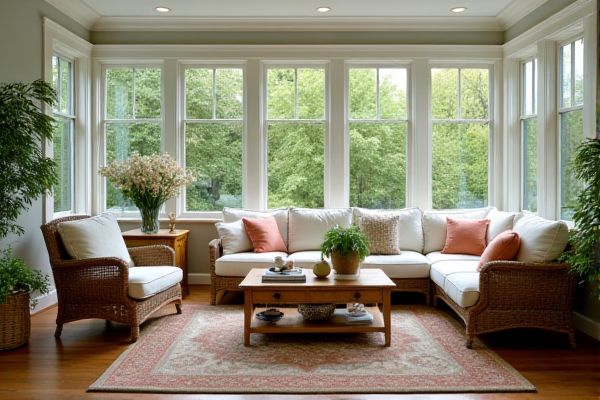
Choosing between indoor and outdoor furniture for your sunroom depends on factors like exposure to sunlight, humidity, and desired comfort level; outdoor furniture offers durability against elements while indoor furniture provides enhanced coziness and style. Explore the rest of the article to discover which option best suits your sunroom's unique environment and your personal preferences.
Table of Comparison
| Feature | Indoor Furniture | Outdoor Furniture |
|---|---|---|
| Material | Wood, fabric, leather | Wicker, metal, plastic, treated wood |
| Durability | Less resistant to moisture and UV | Designed to withstand sun, moisture, and weather |
| Comfort | High comfort with plush cushions | Durable but sometimes less cushioned |
| Maintenance | Requires delicate cleaning | Easy cleaning, weather-resistant finishes |
| Aesthetic | Elegant, cozy indoor style | Casual, natural, rustic look |
| Cost | Typically affordable | Varies, often higher due to materials |
| Sunroom Suitability | Best for temperature-controlled, low UV environments | Ideal for sun-exposed, variable humidity sunrooms |
Introduction: Choosing the Right Furniture for Your Sunroom
Selecting the right furniture for your sunroom hinges on balancing comfort, durability, and style to suit both indoor and outdoor environments. Indoor furniture offers plush cushions and refined designs ideal for temperature-controlled spaces, while outdoor furniture delivers weather-resistant materials like aluminum, wicker, and treated wood to withstand sunlight and humidity. Assess your sunroom's exposure to elements and your lifestyle to ensure your seating and tables enhance both the usability and aesthetics of your space.
Defining Indoor vs Outdoor Furniture
Indoor furniture for sunrooms typically features materials like wood, fabric, and foam designed for comfort and aesthetics in controlled environments, while outdoor furniture utilizes weather-resistant materials such as aluminum, wicker, and synthetic fibers to withstand elements like sun, rain, and humidity. Your choice impacts durability and maintenance; indoor pieces may deteriorate quickly if exposed to outdoor conditions, whereas outdoor furniture ensures longevity with UV protection and water-resistant coatings. Selecting the right type ensures your sunroom remains both functional and stylish throughout the year.
Material Differences: Durability and Maintenance
Indoor furniture for sunrooms typically features softer materials like upholstered fabrics and wood, which prioritize comfort but require more careful maintenance due to susceptibility to fading and moisture damage. Outdoor furniture uses weather-resistant materials such as aluminum, teak, or synthetic wicker, designed to withstand UV rays, humidity, and temperature fluctuations with minimal upkeep. Choosing materials based on durability and maintenance needs ensures longevity and preservation of aesthetic appeal in sunroom settings.
Sun Exposure: How Materials Respond to Light
Sunroom furniture must withstand varying sun exposure, making material selection crucial for durability and appearance. Outdoor furniture materials like teak, aluminum, and synthetic wicker resist UV rays, preventing fading and degradation, while indoor fabrics and wood can quickly fade or warp when exposed to direct sunlight. Choosing sun-resistant materials ensures Your furniture maintains its color and structural integrity in the bright, sun-filled environment of a sunroom.
Comfort and Aesthetics: Matching Your Style
Indoor furniture for sunrooms offers plush cushions and refined textures that enhance comfort while seamlessly matching traditional or contemporary decor styles. Outdoor furniture provides durability with weather-resistant materials like wicker, aluminum, or teak, maintaining aesthetic appeal in sunlit spaces without compromising style. Selecting pieces that balance soft fabrics and sturdy frames ensures a harmonious blend of comfort and visual charm tailored to your sunroom's ambiance.
Functionality: Usage Needs in a Sunroom
Indoor furniture in a sunroom offers comfort and style tailored for controlled environments, with materials that resist fading but may not withstand high humidity or direct sunlight consistently. Outdoor furniture provides durability and weather resistance suited to sunny, humid conditions, ensuring your sunroom's usage demands are met without frequent wear and tear. Choosing based on your functionality needs will optimize the space's comfort, longevity, and maintenance requirements.
Weather Resistance: Dealing with Humidity and Temperature
Indoor furniture for sunrooms offers comfort but often lacks the durability needed to withstand high humidity and fluctuating temperatures, leading to potential warping or mold growth. Outdoor furniture is designed with weather-resistant materials like teak, aluminum, or synthetic wicker, providing superior resistance to moisture, UV rays, and temperature changes. Choosing outdoor-rated furniture ensures longevity and maintains aesthetics in sunrooms exposed to varying environmental conditions.
Budget Considerations: Cost Comparison
Indoor furniture for sunrooms generally costs less upfront due to less durability requirements, but outdoor furniture, designed to withstand weather exposure, offers longer-term value despite higher initial prices. Materials like aluminum, teak, or synthetic wicker raise the cost of outdoor furniture but reduce maintenance expenses over time compared to indoor wood or fabric pieces. Budget-conscious buyers should weigh the balance between upfront investment and durability to select furniture fitting their financial plan and usage expectations.
Sustainability and Eco-Friendly Options
Sustainable sunroom furniture prioritizes materials like reclaimed wood, bamboo, and recycled metal, reducing environmental impact compared to conventional pieces. Indoor furniture designed for sunrooms often incorporates eco-friendly fabrics such as organic cotton or hemp, while outdoor furniture features weather-resistant, recyclable materials like aluminum and sustainably sourced teak. Choosing furniture with certifications like FSC or GREENGUARD ensures both durability and adherence to environmentally responsible standards.
Final Recommendations: Best Choice for Your Sunroom
Outdoor furniture designed with weather-resistant materials like aluminum, wicker, and quick-dry cushions offers durability and ease of maintenance, making it ideal for sunrooms with significant sun exposure. Indoor furniture provides more comfort options and aesthetic variety but may degrade faster due to UV rays and humidity typically found in sunrooms. For longevity and practicality, selecting high-quality outdoor furniture specifically engineered for sunroom conditions remains the best choice, balancing durability and comfort.
 homyna.com
homyna.com